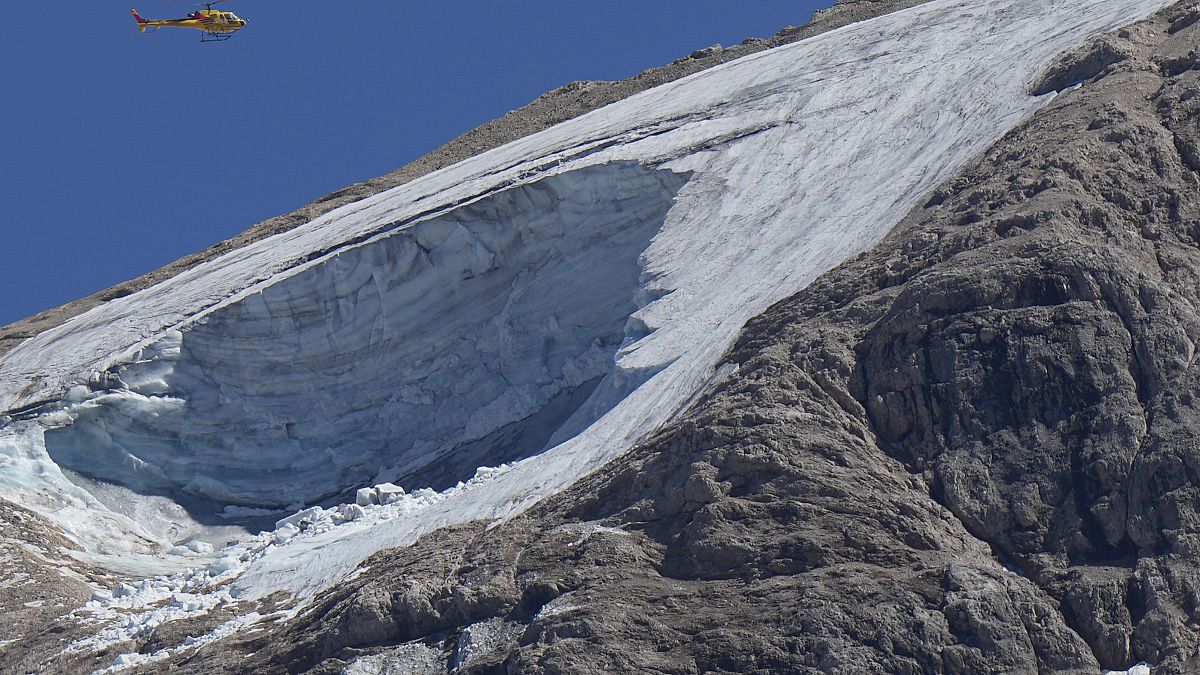At least seven people died and eight were hurt on Sunday when falling ice swept away a group of hikers on the Marmolada glacier, the highest mountain in the Italian Alps.
The search for possible survivors continues after the collapse of a chunk of glacier ice in northeastern Italy, leaving at least ten people dead and several others injured.
The ice crashed into a group of more than a dozen hikers who were making their way across a popular trail on the Marmolada glacier, at more than 3,300 metres the highest mountain in the Italian Alps.
According to Italian media, foreign nationals were among those swept away by the avalanche.
Italian Prime Minister Mario Draghi came to the site of the accident, stating that "Italy mourns these victims and all the Italians are brought together in affection".
Visibly emotional, he said that "this is a drama that certainly has unforeseen elements, but certainly also depends on the deterioration of the environment and the climate situation".
"The government must reflect on what has happened and take measures so that what happened has a low probability of happening (again) and, indeed, will be averted."
"Now we must take measures so that what happened on the Marmolas does not happen again in Italy," Draghi said at the Dolomites resort town of Canazei, ANSA news agency reported.
The head of civil protection in Veneto province, Gianpaolo Bottacin, was quoted by ANSA stressing that the situation was “evolving” and that seven people had died and there could be perhaps 15 people missing.
On Tuesday (5 July), authorities revised the figure to confirm that at least five were unaccounted for.
With the aid of drones, authorities then announced that three more bodies were spotted at the edge of tons of debris, taking the death toll to ten.
Helicopters and rescue dogs deployed
Late on Sunday evening, the Corps tweeted a phone number to call for family or friends in case of "failure to return from possible excursions” to the glacier.
Immediately after the avalanche, five rescue helicopters and dozens of Alpine search and rescue specialists, including rescue dogs, were deployed to help in the rescue operation. But the search had to be suspended at nightfall before resuming Monday morning.
"We saw dead (people) and enormous chunks of ice, rock,'' exhausted-looking rescuer Luigi Felicetti told Italian state TV.
A spokeswoman for the rescue service described "an avalanche of snow, ice and rock that hit the access route as it passed by, with several roped parties being swept away". "The final number of climbers involved is not yet known," she added.
Footage filmed from a hut near the disaster shows snow and rock tumbling down the mountain with a loud crash. Other images taken by tourists on their mobile phones show the grey tongue of the avalanche sweeping away everything in its path, leaving no chance for the climbers.
In images transmitted by the Alpine rescue service, rescuers could be seen working near the scene of the disaster, not far from the departure point of the cable car leading to the top of the glacier. Helicopters flew over the area, ready to transport victims down the valley to the village of Canazei.
The rescuers' work was particularly difficult, as they had to extract the bodies from the ice and rock where they were lying.
A crisis counselling unit was also activated to help the victims' relatives. The public prosecutor's office in Trento has opened an investigation to determine the causes of the tragedy.
'Queen of the Dolomites'
The Marmolada glacier, nicknamed the "Queen of the Dolomites", is the largest glacier in the northern Italian mountain range, which is part of the Alps. Situated in the Trentino region, it gives rise to the Avisio River and overlooks Lake Fedaia.
The glacier collapsed near Punta Rocca, along the route normally taken to reach its summit. It happened a day after the temperature at the top of the glacier reached a record high of 10°C.
People ski on the glacier in the winter, but in recent years it has been rapidly melting away.
"The glacier destabilized at its base due to the large availability of melting water after weeks of extremely high and above average temperature," the Alpine-Adriatic Meteorological Society wrote on Twitter, also posting video of the ice avalanche.
But Walter Milan of the National Alpine and Cave Rescue Corps stressed that high heat was only one possible factor in Sunday's tragedy.
“There are so many factors that could be involved,'' Milan said. Avalanches in general aren't predictable, he said, and heat's influence on a glacier “is even more impossible to predict.”
A report by the Intergovernmental Panel on Climate Change (IPCC), published on 1 March, identified melting ice and snow as one of the 10 major threats caused by global warming, disrupting ecosystems and threatening infrastructure.
Experts at Italy’s state-run CNR research center, which has a polar sciences institute, says the glacier won't exist anymore in the next 25-30 years and much of its volume is already gone.
The Mediterranean basin, shared by southern Europe, the Middle East and northern Africa, has been identified by UN experts as a “climate change hot spot,” likely to suffer heat waves and water shortages, among other consequences.


